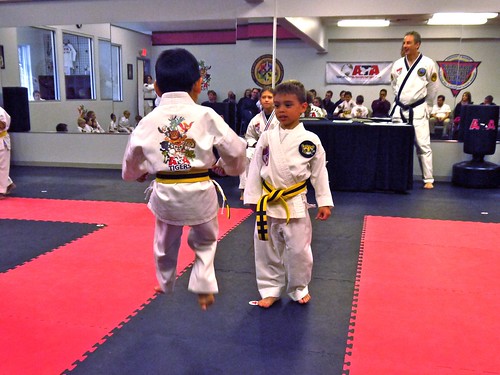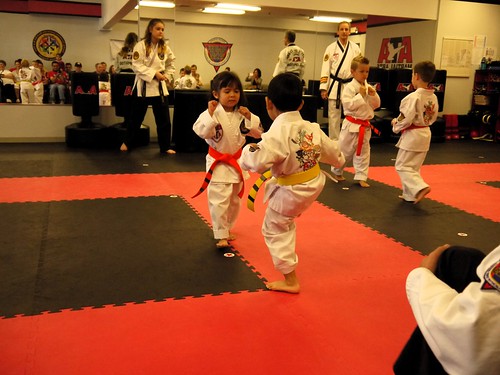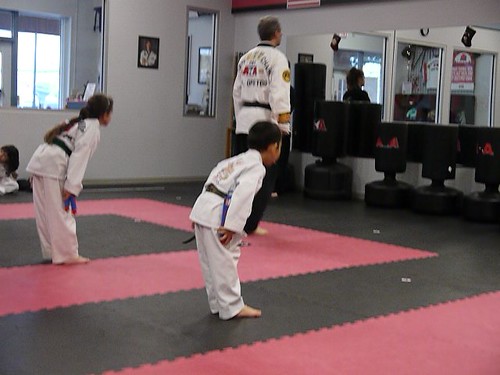We went to a relatively new school that was part of the American Taekwondo Association (ATA) . The impact of being fairly new are that it was still fairly small and it had not generated any black belts yet, so the first benefit was he got a lot of individual attention. The first times he went he looked but did not do anything, which was expected. The school staff spent a lot of individual time with him talking to him and getting him comfortable. In the meantime he observed what was happening. Eventually, he got onto the floor and started participating.
The first benefit we saw was increased confidence. Taekwondo represented a set of skills that he could learn and be competent in, and his attention span helped greatly here. He dealt with the instructors and interacted more freely with the other kids than he did before. A few months in, he had an interview with a prospective kindergarten, and he warmed up to the staff much easier than he had to any other adult (e.g. Day care staff) before. (He usually took 3 months to warm up to new day care staff, either new hires or for when he moved rooms). The curtesies of the school have helped him navigate everyday life in interacting with adults.
The second benefit was concentration and focus, T always had a good attention span, his day care noted that he was a child who stayed in place while the chaos of preschoolers moved around him from activity to activity. Taekwondo added a long term focus onto this, coupled with his natural attention span, meant that the forms and patterns were something he could develop competency in. So, in contrast to the usual criticism of youth Taekwondo as being merely moving limbs, he learned to put power in his moves. And having an object of focus has helped in his usual shyness and tendency to freeze in public view.
 |
| Jump front kick while line sparring |
The other thing we are looking at in the school is how the older kids are like. Once we figured out that T liked this, and we were in this for the long term, we wanted to know who would be influencing him. In a martial arts school, this would mean the kids who reach black belt and become assistant instructors themselves. We have had some interaction as some of the teens have started assisting with classes. But my real interaction has started when I started taking Taekwondo myself. The classes are small, as it is only two years old, but you see the teens supporting one another, and also you see the older ones, who are approaching the black belt ranks, taking seriously the role of encouraging the others, it was a different experience to have a group of teens providing encouragement to an adult (me) in my first month.
One other thing that we are looking forward to is that as the years go on, he will know people in his life who have taken this path before, and unlike sports heroes, these are people he knows in the flesh. In addition to Masters level black belts he will meet in the course of his training, he knows people with black belts or equivalent in various disciplines, and people who compete at the highest levels. So the people he sees on YouTube or in other media are real people, and represent something that can be realistically aspired to.
 |
| Line sparring |
One other thing that we are looking forward to is that as the years go on, he will know people in his life who have taken this path before, and unlike sports heroes, these are people he knows in the flesh. In addition to Masters level black belts he will meet in the course of his training, he knows people with black belts or equivalent in various disciplines, and people who compete at the highest levels. So the people he sees on YouTube or in other media are real people, and represent something that can be realistically aspired to.


No comments:
Post a Comment